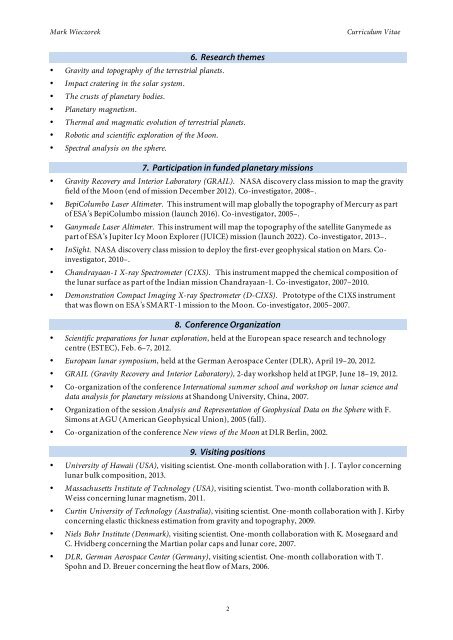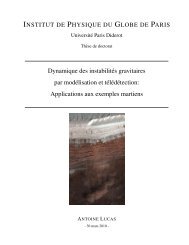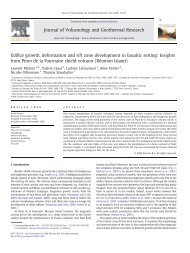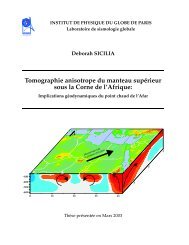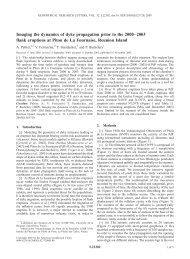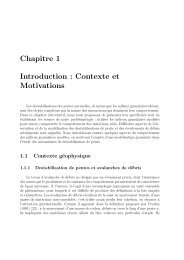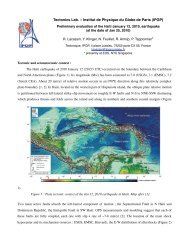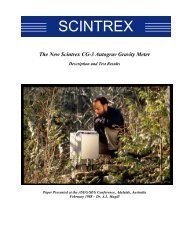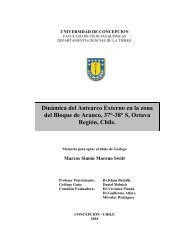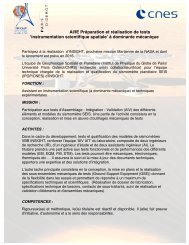Mark A. Wieczorek - Institut de Physique du Globe de Paris
Mark A. Wieczorek - Institut de Physique du Globe de Paris
Mark A. Wieczorek - Institut de Physique du Globe de Paris
You also want an ePaper? Increase the reach of your titles
YUMPU automatically turns print PDFs into web optimized ePapers that Google loves.
<strong>Mark</strong> <strong>Wieczorek</strong><br />
Curriculum Vitae<br />
• Gravity and topography of the terrestrial planets.<br />
• Impact cratering in the solar system.<br />
• The crusts of planetary bodies.<br />
• Planetary magnetism.<br />
6. Research themes<br />
• Thermal and magmatic evolution of terrestrial planets.<br />
• Robotic and scientific exploration of the Moon.<br />
• Spectral analysis on the sphere.<br />
7. Participation in fun<strong>de</strong>d planetary missions<br />
• Gravity Recovery and Interior Laboratory (GRAIL). NASA discovery class mission to map the gravity<br />
field of the Moon (end of mission December 2012). Co-investigator, 2008–.<br />
• BepiColumbo Laser Altimeter. This instrument will map globally the topography of Mercury as part<br />
of ESA’s BepiColumbo mission (launch 2016). Co-investigator, 2005–.<br />
• Ganyme<strong>de</strong> Laser Altimeter. This instrument will map the topography of the satellite Ganyme<strong>de</strong> as<br />
part of ESA’s Jupiter Icy Moon Explorer (JUICE) mission (launch 2022). Co-investigator, 2013–.<br />
• InSight. NASA discovery class mission to <strong>de</strong>ploy the first-ever geophysical station on Mars. Coinvestigator,<br />
2010–.<br />
• Chandrayaan-1 X-ray Spectrometer (C1XS). This instrument mapped the chemical composition of<br />
the lunar surface as part of the Indian mission Chandrayaan-1. Co-investigator, 2007–2010.<br />
• Demonstration Compact Imaging X-ray Spectrometer (D-CIXS). Prototype of the C1XS instrument<br />
that was flown on ESA’s SMART-1 mission to the Moon. Co-investigator, 2005–2007.<br />
8. Conference Organization<br />
• Scientific preparations for lunar exploration, held at the European space research and technology<br />
centre (ESTEC), Feb. 6–7, 2012.<br />
• European lunar symposium, held at the German Aerospace Center (DLR), April 19–20, 2012.<br />
• GRAIL (Gravity Recovery and Interior Laboratory), 2-day workshop held at IPGP, June 18–19, 2012.<br />
• Co-organization of the conference International summer school and workshop on lunar science and<br />
data analysis for planetary missions at Shandong University, China, 2007.<br />
• Organization of the session Analysis and Representation of Geophysical Data on the Sphere with F.<br />
Simons at AGU (American Geophysical Union), 2005 (fall).<br />
• Co-organization of the conference New views of the Moon at DLR Berlin, 2002.<br />
9. Visiting positions<br />
• University of Hawaii (USA), visiting scientist. One-month collaboration with J. J. Taylor concerning<br />
lunar bulk composition, 2013.<br />
• Massachusetts <strong>Institut</strong>e of Technology (USA), visiting scientist. Two-month collaboration with B.<br />
Weiss concerning lunar magnetism, 2011.<br />
• Curtin University of Technology (Australia), visiting scientist. One-month collaboration with J. Kirby<br />
concerning elastic thickness estimation from gravity and topography, 2009.<br />
• Niels Bohr <strong>Institut</strong>e (Denmark), visiting scientist. One-month collaboration with K. Mosegaard and<br />
C. Hvidberg concerning the Martian polar caps and lunar core, 2007.<br />
• DLR, German Aerospace Center (Germany), visiting scientist. One-month collaboration with T.<br />
Spohn and D. Breuer concerning the heat flow of Mars, 2006.<br />
2


